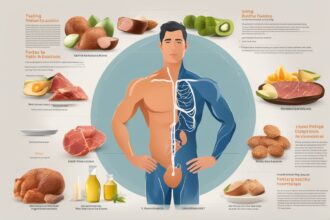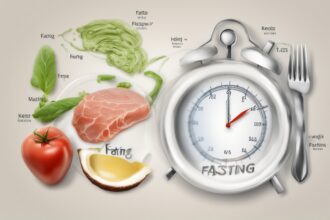Let’s dive into a topic that’s been buzzing in health circles for years now: achieving optimal nutrition during ketosis. If you’ve ever embarked on a ketogenic diet—or even flirted with the idea—you know it’s not just about slashing carbs and loading up on fats. It’s a delicate dance of fueling your body right while maintaining that coveted state of ketosis, where your body burns fat for energy instead of glucose. But how do you ensure you’re not just surviving but thriving on this high-fat, low-carb lifestyle? That’s the million-dollar question, and I’m here to break it down with practical tips, personal insights, and science-backed advice.
What Is Optimal Nutrition During Ketosis?
Optimal nutrition during ketosis isn’t just about hitting your macro goals—though, trust me, tracking those fats, proteins, and carbs is a big piece of the puzzle. It’s about nourishing your body with the right nutrients to support energy, mental clarity, and overall well-being while keeping your ketone levels in check. Imagine you’re deep into keto, feeling that initial surge of focus and stamina, but then—bam!—you hit a wall because you’re missing key vitamins or electrolytes. I’ve been there, and it’s not pretty. Think fatigue, brain fog, or even the dreaded “keto flu.” Optimal nutrition means avoiding these pitfalls by prioritizing quality over quantity and balance over blind restriction.
At its core, this approach involves getting enough healthy fats (think avocados, coconut oil, and nuts), moderate protein (like grass-fed beef or wild-caught salmon), and minimal carbs (mostly from leafy greens or low-glycemic veggies). But it’s also about micronutrients—those vitamins and minerals that keep your body humming. And don’t forget hydration and electrolytes; they’re the unsung heroes of ketosis. Let’s unpack how to make this work for you.
Why Nutrition Matters More in Ketosis
When you’re in ketosis, your body is running on a completely different fuel system. Instead of relying on quick-burning glucose from carbs, it’s producing ketones from fat to power everything from your brain to your muscles. Sounds efficient, right? But here’s the catch: this metabolic shift puts extra stress on your system, especially in the early stages. Without the right nutrition, you risk nutrient deficiencies, sluggish energy, or even kicking yourself out of ketosis by accident. I remember my first keto stint—three weeks in, I was so focused on bacon and butter that I neglected veggies. Big mistake. My energy tanked, and I felt like I was dragging myself through molasses.
Research backs this up. A study published in the Journal of the International Society of Sports Nutrition highlights that while the ketogenic diet can be effective for weight loss and metabolic health, inadequate nutrient intake can lead to issues like muscle loss or impaired recovery. That’s why a well-rounded diet—yes, even on keto—is non-negotiable. It’s not just about staying in ketosis; it’s about feeling your best while you’re there. Curious about how keto impacts energy long-term? Check out our post on Sustaining Energy on a Keto Diet for a deeper dive.
Key Nutrients for Optimal Nutrition During Ketosis
So, what should you focus on to nail optimal nutrition during ketosis? Let’s break it down into actionable categories. First up, fats—aim for 60-75% of your calories from healthy sources. I’m talking olive oil for drizzling on salads, fatty fish like mackerel for omega-3s, and even a spoonful of MCT oil in your coffee for a quick ketone boost. But don’t overdo saturated fats without balancing them with unsaturated ones; your heart will thank you.
Next, protein. This is where a lot of keto newbies trip up, either eating too much (which can spike glucose via gluconeogenesis) or too little (which risks muscle loss). Stick to 15-25% of your calories from high-quality protein. Think eggs, poultry, or even plant-based options like tofu if you’re mixing things up. I’ve found that keeping a small stash of hard-boiled eggs in the fridge saves me on busy days when I’m tempted to skimp.
Carbs are the tricky part—keep them under 5-10% of your intake, mostly from nutrient-dense sources like spinach, kale, or broccoli. These not only keep carbs low but also pack in fiber, vitamins, and minerals. And speaking of minerals, don’t sleep on electrolytes like sodium, potassium, and magnesium. When I first started keto, I didn’t realize how much water and salt I was losing. Cue the headaches and leg cramps. A pinch of Himalayan salt in my water and a daily magnesium supplement turned things around fast.
Lastly, don’t ignore vitamins. A multivitamin can be a safety net, but I prefer getting mine from food—think vitamin D from fatty fish or B vitamins from organ meats (if you’re adventurous). Want more on balancing macros? Our guide on Calculating Keto Macros has you covered.
Common Pitfalls and How to Avoid Them
Even with the best intentions, it’s easy to stumble on the keto journey. One major pitfall is under-eating calories. Yes, keto can suppress appetite (a blessing and a curse), but if you’re not eating enough, your metabolism might slow, and you’ll feel drained. I’ve had days where I was so busy I forgot to eat until dinner, only to wonder why I felt like a zombie. Use a tracking app, at least in the beginning, to ensure you’re hitting your calorie needs.
Another trap is “dirty keto”—relying on processed foods like keto bars or sugar-free sodas. Sure, they fit the macros, but they’re often devoid of real nutrition. I fell into this trap early on, grabbing convenience foods when life got hectic. My digestion paid the price. Stick to whole foods as much as possible; your gut will thank you. And don’t forget variety. Eating the same three meals on repeat might keep you in ketosis, but it can lead to nutrient gaps. Mix in different fats, proteins, and veggies to keep things interesting and balanced.
Practical Tips for Sustaining Optimal Nutrition
Let’s get down to brass tacks—how do you make optimal nutrition during ketosis a reality in your day-to-day life? Start with meal planning. I can’t stress this enough. On Sundays, I batch-cook a big tray of roasted veggies with olive oil and whip up a few protein options like grilled chicken or salmon. It’s a lifesaver during the week when I’m juggling deadlines and don’t have time to cook from scratch.
Next, keep keto-friendly snacks handy. A small bag of macadamia nuts or a few slices of cheese can tide you over without derailing your macros. Hydration is another non-negotiable—aim for at least 8-10 glasses of water a day, more if you’re active. I carry a reusable bottle with a pinch of salt and a splash of lemon for flavor; it’s a game-changer. And if you’re struggling with cravings or energy dips, consider exogenous ketones or a small dose of MCT oil—but don’t rely on them as a crutch. Real food should always be your foundation.
Lastly, listen to your body. Ketosis isn’t a one-size-fits-all deal. Some days, you might need a bit more protein; others, a few extra carbs from berries might feel right. I’ve learned to tweak things based on how I feel, and it’s made all the difference. For more on personalizing your approach, read up on Tailoring Keto to Your Needs.
Balancing Ketosis with Long-Term Health
Here’s where I’ll put on my “big picture” hat. Ketosis can be incredible for weight loss, mental clarity, and even managing conditions like type 2 diabetes (with medical supervision, of course). But optimal nutrition during ketosis isn’t just about the now—it’s about sustainability. Are you setting yourself up for long-term health, or are you risking burnout by pushing too hard? I’ve seen friends dive into keto with gusto, only to crash months later because they ignored balance. Don’t let that be you.
Work with a dietitian if possible, especially if you have underlying health conditions. Keep an eye on blood markers like cholesterol and triglycerides—keto can affect them, for better or worse. And remember, keto doesn’t have to be forever. Cycling in and out with higher-carb days (aka cyclical keto) might be a better fit for some. The goal is health, not dogma. Focus on nutrient density, listen to your body, and adjust as needed. That’s the real secret to thriving in ketosis.
References
- Journal of the International Society of Sports Nutrition: Ketogenic Diet and Its Effects on Body Composition
- National Institutes of Health: The Ketogenic Diet and Its Clinical Applications
- Harvard Health: Is the Ketogenic Diet Good for You?
- Mayo Clinic: Low-Carb Diet and Nutritional Considerations
This content is for informational purposes only and not a substitute for professional advice.






